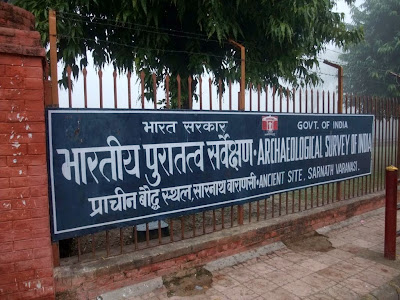


The Deer Park Mrigadava in Sarnath originally a forest Benares King Jakata offered for the wild and unmolested deers to roam and wander around, was the place where a monastic tradition flourished for 1500 years. It is the site where Lord Buddha delivered his first sermons after his enlightenment to the five Pancavaggiya monks who left him after he gave up his austere penances. He taught them 4-noble truths and 8-fold paths and subsequently his first 5 disciples achieved enlightenment and became Arahats. Buddha also preached many other sutta while staying in Mrigadava. Buddhist community of Sangha was then found and formed from here. It was said that the numbers of monk began with 5 increasing to 60 during Buddha's time and growing to 12000 in 2nd century. The travel accounts of Chinese monk Rev. Xuanzang disclosed that there were 3000 monks and 300 monasteries when he visited Sarnath in 7th century. Sarnath was leveled to ground in the invasion of Muslims led by Kutubuddin Aibak in year 1194 and remained as a forest of debris with all historical ruins buried underground.
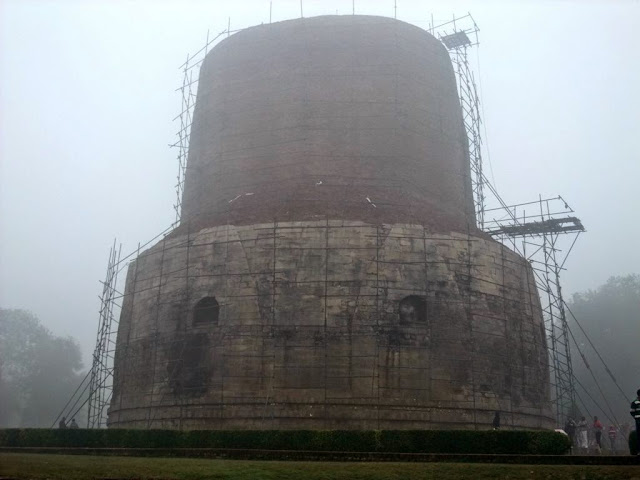

The most conspicuous and imposing structure in Sarnath is Dhamekh Stupa which was also known as Dhamekha. It is one of the most prominent Buddhist structure in India. The present existing solid cylindrical building was believed to have been constructed in year 500 during Gupta era, over the original site of a structure built by Mauryan King Ashoka in year 249BC.



Dhamek Stupa is a solid cylinder built with bricks and stones measures with a height of 43.6 meter and 28 meter in diameter. The base of the stupa was most probably sitting on the original site of the earlier building. The successive structure had merged into the old one and embellished it.




The lower part of Dharmek Stupa is fully covered with fascinated stone carved designs, with floral patterns of Gupta period (4th-6th century), attractive figures of humans, birds and some Brahman scripts.



The decorative designs at some part consist of a broad bank of swastika carved out in different geometrical patterns with a finely chiseled lotus wreath, running over and below it.



Dhamekh Stupa is the most auspicious site for most Buddhist Pilgrims who normally would circled round the Stupa while doing some recitation of Buddhist verses.


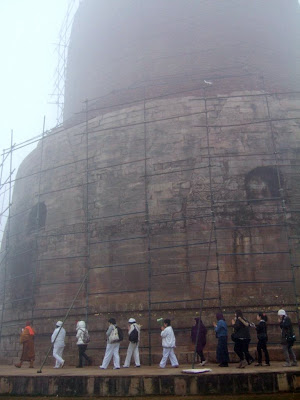
Following behind the steps of Thai monk, we mindfully circled round Dhamekh Stupa three times in a chilly misty morning.


The word Dhamekha was found on a stone tablet from the top center of Dhamekh Stupa unearthed during excavation. The inscription mentioned that this was the spot where Buddha delivered his first sermon. It was also believed that the place could also be the site of the living huts where the five ascetics used to stay after they left Bodhgaya.




Sarnath also known as Isipatana in the past, which means landing place of holy man. It was located near the confluence of Ganges and Gomati River 13km away north east of Varanasi. Sarnath is one of the four main Buddhist pilgrimage destinations as it was where the first turning of Dharma Wheel took place.



Buddhism flourished in Sarnath for more than 15 decades partly was because of its position. It neighbored with Varanasi which was an important arts center from 3rd to 6th century and a place where Kings and wealthy merchants lived.


Remnants and ruins of monasteries, temples and votive stupas are found in a labyrinth enclosed inside the main area.



There are many ruins of small stupas, vihars and small temples.




Votive stupas were basically built to commemorate the visits of various acknowledged Buddhist masters and dignities.




After the city was sacked by Turkish Muslims in 12th century, the Buddhist prosperous sites was completely destroyed and structures were subsequently plundered for building materials.






The most of the remains were from time of Maurya King Ashoka (268-232BC).



The impressive stone carvings arts at the broken ruins.












Panchaytan Temple was the sunken shrine of four square temples dated to Gupta period in 4th -6th century. It was the site where Buddha converted the rich merchant Yasha to Buddhism.



Pilgrims paying homage to Panchaytan temple.


The shrines from four corners of Pancayatana Temple.






The remnant amidst in the middle of the ruins is Mulagandha Kuti Vihara, It was the site of a huge temple where Lord Buddha spent his first rainy season and sat for meditation.


There was no roof but remains of thick walls that supported a lofty super structure. Basing on its brick molded structure and architectural decorative patterns, Mulgandakuti Vihara most probably was constructed within 4th to 6th century, during Gupta period.


The Chinese renowned monk Rev. Xuanzang who visited the place in 7th century, described The Mulgandakuti Vihara as a lofty super huge structure supported and surrounded by thick walls and had a height of about 61 meters.



The Temple Mulgandakuti Vihara was raised on a square platform measured at about 18.3 meters in width. The entrance faced east with a rectangular mandapa and a long open courtyard. Every parts of the remaining walls were pasted with gold foil by devout pilgrims whose strong faith may have make them ignore the sign of " No Stick of Gold Foil" standing in the compound.


The broken parts of the most celebrated Ashoka Pillars built by King Ashoka remained at the original site in Sarnath. Pillar was completed with a lion capital at its top when it was first built in year 250Bc. During Turk invasion, the lion capital was broken off and dropped from 45 feet down to the ground but miraculously survived. The lion capital which is now the National Emblem and national symbol of India, is now displaced in Sarnath Museum.
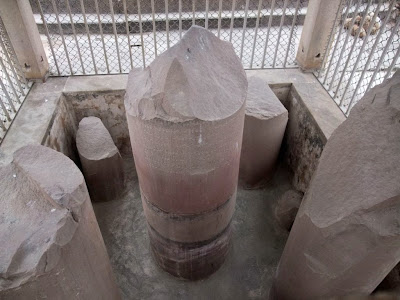


The Brahmin inscription at Ashoka main pillars indicated that this was the spot where Lord Buddha preached his first sermon. King Ashoka erected pillar to commemorate his visit in 3rd century BC..

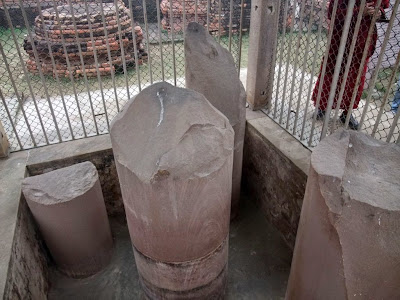
Hidden inside these beautiful ornamented broken pillars is an important building part of Great Dharmarajika stupa, Monolithic Railing.




Monolithic Railing which was most probably the part placed on top of Dharmarajika stupa, was found during the excavation in year 1904-5.


Monolithic Railing was made from Chunar sandstone and measured 2.54m in length by 1.45m in height. The two inscriptions revealed that it was dated to 3rd century BC and related to the teachers of Sarvastivadin sect.


Large area of ruins and remains of a cluster of small votive stupas and temples.





Dharmarajika stupa was the place where Pancavaggiyas spent their time in medication before Lord Buddha arrived. The site where 500 Pacceka Buddhas entered into Nirvana and the place where Metreyya received assurance of his becoming the next Buddha, were all within the vicinity nearby Dharmarajika Stupa.



Dharmarajika stupa was one of two great Stupas that adorned the Buddhist City of Sarnath in the past but now only remain a large circular base made of layers of bricks with a completely flat upper surface.


Dharmarajika stupa was one of the Stupas built by King Ashoka to enshrine the relics of Buddha that he had extracted from the main eight relic original stupas. In 18th century, Dharmarajika Stupa was completely destroyed by Raja Chet Singh of Banaras and its structural parts were removed to Varanasi to be used as building materials for other temples. Relics found inside the stupa were all thrown into Ganges River.



Though the huge and grand brick structure remained only a flat circular structure of its bricks foundation, it was still one of the most significant Buddhist sites to all Buddhist Pilgrims.



Follow the trails to explore and pay homage to one of the most sacred Buddhist site around the archaeological complex of Sarnath.




The remnant of Sarnath site was re-discovered by British general Colonel Alexandra Cunningham who found Migadaya in 20th century. The site was identified as the ancient Isipatana where Lord Buddha delivered the historic First Sermon Dhammacakkappavattana Sutta and the second sermon Anattalakkhana Sutta and as well as the founding of the Sangha.



The main entrance of Sarnath Archeological complex.


